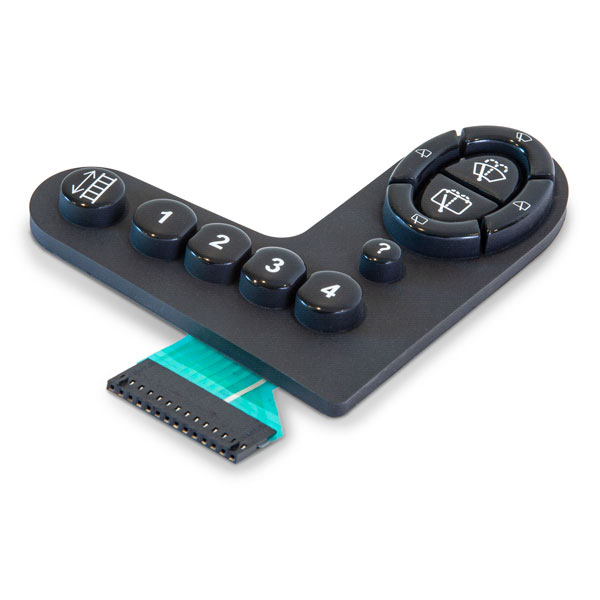Top Features to Look for in a High-Quality Membrane Switch
Top Features to Look for in a High-Quality Membrane Switch
Blog Article
Recognizing Membrane Layer Switches: The Secret to Dependable and long lasting Controls

What Are Membrane Layer Buttons?
Membrane layer switches are a sophisticated remedy in the world of individual interface innovation, integrating capability and style seamlessly. These gadgets act as an interface in between users and digital systems, integrating a number of components right into a compact style. Normally created from adaptable, thin layers of products, membrane layer buttons are designed to react to touch, making it possible for individuals to connect with machinery and digital gadgets effectively.
The main elements of a membrane layer switch consist of a published circuit layer, visuals overlay, and a spacer layer that prevents unplanned activation. The visuals overlay can be tailored to reflect brand identity or user choices, boosting aesthetic appeals while ensuring use. Membrane layer switches are frequently used in numerous applications, consisting of medical devices, customer electronic devices, and industrial devices, owing to their sturdiness and resistance to ecological variables such as wetness and dust.
Among the vital advantages of membrane switches is their capability to hold up against wear and tear, making them suitable for high-traffic environments. Furthermore, they are light-weight and need minimal room, enabling ingenious designs in item advancement. In general, membrane layer switches stand for a efficient and sensible option for contemporary digital interfaces, marrying innovation with user-centric layout principles.
How Membrane Layer Changes Job
The procedure of membrane layer switches over depend upon a simple yet reliable system that translates user input right into digital signals. These buttons include several layers, usually consisting of a visuals overlay, a spacer layer, and a circuit layer. When a user presses the button, the top layer flaws, allowing a conductive aspect in the circuit layer to make call with a corresponding conductive pad on the underside of the visuals overlay. This get in touch with shuts the circuit and sends out an electronic signal to the device, indicating that the switch has been triggered.
The layout of membrane layer switches can differ, however they often incorporate domes or responsive elements to give responses to the customer, boosting the total experience - membrane switch. The products used in membrane buttons, such as polyester or polycarbonate, add to their durability and resistance to environmental factors, including moisture and dust. The published circuits are normally enveloped, which shields them from wear and tear over time.
Advantages of Membrane Layer Switches

Additionally, membrane buttons are understood for their durability. Constructed from durable materials, they are immune to dirt, moisture, and physical wear, which dramatically expands their life expectancy compared to typical mechanical buttons. This durability makes them particularly suitable for high-traffic settings and applications needing durability.
An additional considerable advantage is the simplicity of cleansing and maintenance. The smooth surface area of membrane layer switches over reduces dust build-up and is often unsusceptible spills, making them ideal for settings that call for check my source regular sanitization.
In addition, membrane layer buttons offer a structured profile, resulting in a thinner style that can be incorporated right into numerous gadgets without adding mass. This feature not only improves the visual charm but also adds to a much more ergonomic item layout.
Applications of Membrane Switches
Flexible and user-friendly, membrane layer buttons find applications throughout a vast array of markets, consisting of clinical tools, consumer electronics, and commercial equipment. In the clinical area, these buttons are essential to gadgets such as analysis tools, patient monitoring systems, and infusion pumps, where reliability and convenience of cleansing are important. Their capability to stand up to harsh atmospheres and keep functionality makes them perfect for such applications.

In customer electronics, membrane layer buttons are utilized in items like microwaves, washing machines, and remote controls - membrane switch. Their sleek style enables instinctive interface, enhancing the overall individual experience while giving sturdiness and resistance to use and tear
Industrial tools additionally takes advantage of membrane buttons, particularly in control panels for machinery and automation systems. These switches supply defense versus dirt and moisture, guaranteeing regular efficiency in difficult atmospheres. Their customizable functions permit suppliers to customize them to details functional needs, enhancing effectiveness and capability.
Picking the Right Membrane Layer Change
When picking a membrane switch, it is important to think about numerous variables that influence performance and viability for details applications. The key considerations consist of ecological problems, tactile comments, durability, and layout my blog requirements.
First, assess the operating setting; switches exposed to dampness, chemicals, or severe temperatures require certain materials to make certain durability and functionality. Next off, assess the requirement for responsive feedback. Depending upon customer interaction, some applications might gain from a tactile response to validate activation, while others might choose a non-tactile layout for aesthetic reasons.
Sturdiness is another essential element; membrane layer buttons ought to be developed to withstand constant use, effects, and abrasion. Make sure the selected button can withstand the anticipated lifecycle, especially in high-usage situations.

Conclusion
In verdict, membrane layer switches over offer as vital components in the design of durable and dependable control systems throughout numerous industries. The versatility of membrane layer switches permits for tailored options that fulfill details operational demands, reinforcing their value in modern-day innovation.
Membrane changes represent a crucial aspect of contemporary user interface layout, mixing functionality with strength in different applications.Membrane layer buttons are a sophisticated option in the realm of customer interface technology, integrating performance and layout flawlessly. Commonly created from adaptable, thin layers of materials, membrane switches are designed to react to touch, making it possible for individuals to connect with machinery and digital gadgets effectively.
The design of membrane layer buttons can vary, however they often integrate domes or responsive aspects to offer responses to the individual, enhancing the overall experience.In conclusion, membrane layer switches serve as essential components in the layout of sturdy and trusted control systems throughout various sectors.
Report this page